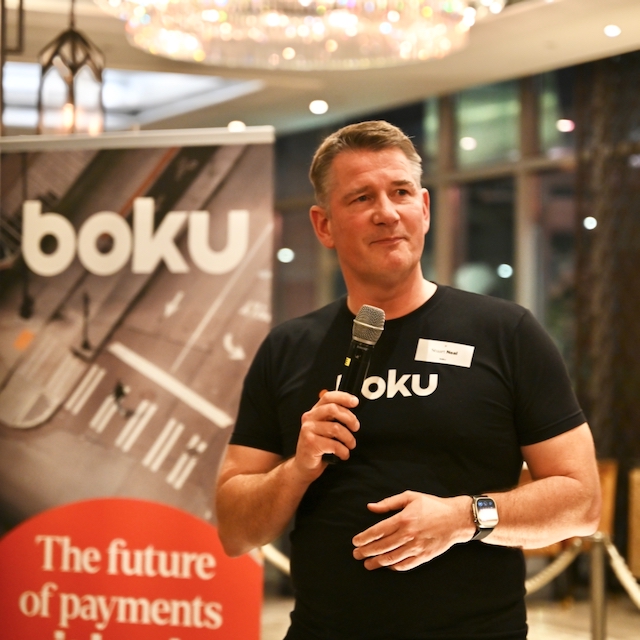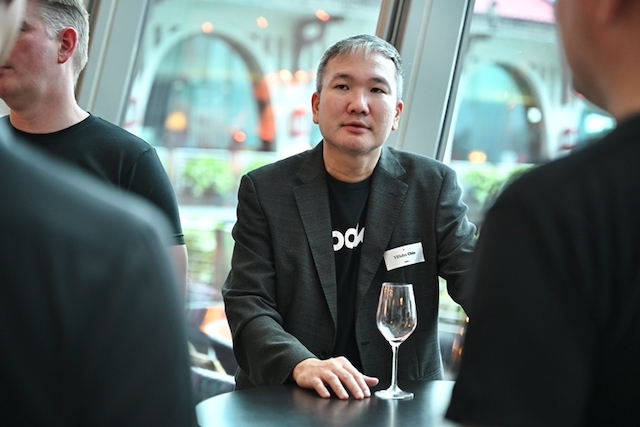
Boku’s APAC team spent three days at Singapore Fintech Festival – the world’s largest fintech gathering – listening to merchants, wallet providers, and banking partners.
Here’s what we learned about where payment innovation is actually heading, and what it means for platforms operating across borders.
The Context
Singapore Fintech Festival 2025 was impossible for Boku to miss. With 60,000 attendees marking the event's 10th anniversary during Singapore's 60th year of independence, the festival confirmed what we already knew: APAC is the epicenter of payment innovation.
Booths, panels, and pitch decks can tell you what vendors want the market to believe. The harder, and more valuable, exercise is understanding what merchants actually need when they expand across borders.
So on Thursday November 13, Boku hosted 58 guests at the Fullerton Bay Hotel in an intimate gathering with folks from several of the world’s largest digital streaming merchants and major APAC local payment methods partners, and global banking partners navigating interoperability challenges.
Our Global Leadership Team flew in. Stuart Neal, Boku’s CEO, announced the launch of Boku's Innovation Hub in Singapore, followed by some context setting from Yi Hahn Chin, Head of FX and Money Movement. But our speeches were brief - the point was to listen.


Here's what we heard. And more importantly, what it means for you.
Theme 1: Money Movement is the New Battleground
If there was one phrase that cut through every conversation, it was "money movement." Not payments. Not checkout optimization. Money movement i.e the entire lifecycle of how funds flow in, through, and out of a platform.
What Merchants Told Us Were Their Pains
The gig economy challenge:
Ride hailing platforms don't just need to accept payments from riders - they need to pay drivers instantly, in their preferred local method, without crushing margins with FX spreads and payout fees. One merchant described their current process as "death by a thousand wire transfers."
The creator economy gap:
Streaming platforms pay influencers and creators. But legacy payout infrastructure - ACH, wire transfers, mobile wallets weren’t built for hundreds of thousands of small-value, cross-border disbursements. The cost per transaction makes micro-payments uneconomical.
The marketplace squeeze:
E-commerce marketplaces operating across APAC face a cruel irony: they've mastered collecting payments from buyers in dozens of local methods, but they're settling with sellers using expensive, slow bank transfers. The disconnect between pay-in sophistication and pay-out capability is costing them both money and merchant satisfaction.
Why This Matters Now
Loke Hwee Wong, VP & GM, APAC, observed during the mixer: Merchants used to ask us 'Can you help us accept more payment methods?' Now they're asking, 'Can you help us move money bidirectionally?
The shift reflects platform evolution. When you're focused on growth, you optimize checkout. When you're focused on margins, you optimize the entire money movement stack - including the outbound flows most vendors ignore.
Boku's exploration of LPM-based payouts isn't theoretical. Merchants are already asking: "You connect us to GCash for pay-ins. Can consumers receive payouts to GCash too?" The infrastructure for bidirectional flows exists. The business models, compliance frameworks, and integrations are what needs to be built.
Theme 2: AI is Moving from Buzzword to Business Process
AI dominated SFF programming, but the most interesting conversations happened away from the main stage, where merchants admitted what they're actually doing with AI versus what’s being discussed online.
The Three AI Applications That Matter
1. Process Optimization in Payments
Merchants are using AI to optimize payment routing, reduce false declines, and improve authorization rates - turning involuntary churn from a cost center into a competitive advantage.
Shi Jing Chee, Senior Key Account Director APAC’s takeaway: "AI as a process and optimization engine into the payments ecosystem, that's where we're seeing real adoption. Not chatbots, not customer service. Actual payments infrastructure improvement."

2. Fraud Detection (Obviously)
Every merchant mentioned fraud. But the sophistication gap is widening: large enterprises are using agentic AI that learns in real-time, while mid-market companies are stuck with rule-based systems that flag legitimate customers.
3. Agentic Commerce (With Major Caveats)
The scariest and most exciting trend: AI agents that make purchasing decisions autonomously. Imagine a business AI that monitors your SaaS stack, negotiates renewals, and switches vendors - without human intervention!
Tracy Prandi-Yuen, VP of Global Partnerships’ observation from SFF: "The moment you introduce agentic commerce, you open questions around liability, fraud, and how you distinguish good bots from bad bots. And when quantum computing enters the picture - which isn't as far off as people think - everything accelerates to a speed where humans can't keep up."

The fraud implications are staggering: quantum-powered AI could decrypt, and exploit systems faster than traditional defenses can respond. It's not science fiction - it was a recurring topic in closed-door sessions at SFF.
What Merchants Should Prioritize
Don't chase AI for AI's sake. Focus on:
- Payment optimization: Authorization rates, routing intelligence, retry strategies
- Fraud prevention: Upgrading from rule-based to learning-based systems
- Watching agentic commerce: Not ready for prime time, but coming fast
Theme 3: Stablecoins – Still Searching for the Killer Use Case
Stablecoins were the topic at SFF 2024. A year later, they're still getting airtime, but the conversation has shifted from "What is this?" to "What is this actually for?"
Tracy's assessment: "Last year, stablecoins and orchestration were the hot topics. This year, orchestration has died down, but stablecoins have sustained interest. The industry is still trying to find relevant use cases - not just trading or investment, but actual commerce."
That shift from "What is this?" to "How do we operationalize this?" was evident throughout SFF. The hype phase is over. The operational question phase has begun.
Proven Value, Bounded Use Cases
Stablecoins have demonstrated clear value in specific scenarios: countries with currency volatility and remittance corridors where capital controls create friction. For these use cases, the benefits are measurable and the adoption is real.
But now, a different conversation is emerging: What are the use cases that make the most sense for users and from an economics point of view, and who are the providers to work with?
The unknowns aren't philosophical. They're operational:
- For merchants serving stable-currency markets: If your customers are largely from the US, Europe, or developed APAC markets with stable currencies, does accepting stablecoins make economic sense? Or is it solving a problem your customers don't have?
- The "stablecoin sandwich" model: In an on-ramp, blockchain settlement, off-ramp flow, what's the optimal way to structure this to maximize cost and efficiency gains? Where do the real savings come from, and where do new costs emerge?
- Regulatory evolution: As stablecoins move beyond early adoption, how will regulatory frameworks evolve—and how will that impact operational feasibility and economics? The uncertainty here isn't technical; it's about compliance costs and cross-border licensing complexity.
- Provider sustainability: Can service providers build sustainable margins in a market where the addressable use cases are specific and bounded? Or does stablecoin infrastructure become a low-margin commodity play?

Boku’s Pragmatic Approach
Boku is exploring stablecoin integration as a pragmatist, focusing on the metrics that matter: speed, cost, reliability, and demonstrated merchant demand.
Yi-Hahn Chin, Head of FX and Money Movement Innovation and co-lead of Boku's Innovation Hub: "A merchant doesn't wake up wanting 'a stablecoin solution.' They want faster cross-border settlement, lower FX costs, or instant payouts. If stablecoins solve those problems better than traditional rails, we'll make them available through the same integration merchants already use for 200+ other payment methods."
That's the litmus test: Does this solve a merchant problem better than existing alternatives? Not "Is this innovative?" Not "Is blockchain the future?" But: Does it deliver measurable value in speed, cost, or reach that traditional payment rails cannot?
The industry is moving from ideology to infrastructure. The merchants who benefit will be the ones who ask the right operational questions - not the ones who chase the narrative.
Theme 4: The QR Payment Landscape - Interoperability at the Edges
While stablecoins grabbed headlines, the most consistent merchant pain point was simpler but harder to solve: payments that don't connect when they need to.
The Maturity Problem
The QR payment landscape in APAC is mature within domestic ecosystems. But friction emerges at the edges, when payment systems need to talk to each other across borders or between incompatible networks.
For digital merchants, this means:
- Integrating wallets one-by-one (6-9 months per market)
- Managing separate reconciliation processes
- Inconsistent user experiences across countries
- High technical debt with no standard like Visa/Mastercard provides for cards
While clear interoperability exists within certain ecosystems. The real challenge lies in connecting across those boundaries, where merchants and consumers face real friction today.
Boku is exploring how to bridge those gaps. Not by building more one-to-one corridors, but by creating infrastructure that lets existing payment systems work together seamlessly.
The Infrastructure Opportunity
This isn't about replacing existing wallets or forcing merchants to adopt yet another payment layer. It's about the connective tissue - the infrastructure that orchestrates existing payment systems, manages routing intelligently, and handles the complexity so merchants and consumers don't have to.
Angie Low, Head of Money Movement Innovation and co-lead of Boku's Innovation Hub, describes what's needed: "The innovation required in payments isn't in building one-to-one corridors, but in creating the infrastructure that lets payment systems talk to each other seamlessly. We're in a unique position to observe which friction points matter most to our merchant partners, and we're thinking deeply about how to remove them through smarter integration and orchestration."
What Wallets Are Actually Asking For
The pressure isn't just coming from merchants - wallet providers themselves are seeking solutions.
Cheryline Fong, VP of Business Development for ASEAN shares what's happening on the ground: "Our key e-wallet partner is asking for e-wallets interoperability within Asia - the ability to enable their users to scan and pay using their local wallet in different Asian countries."
That's the shift: even wallets with tens of millions of users recognize they can't integrate with every other wallet directly. The technical lift is too heavy, the partnerships too complex, the timelines too long. They need infrastructure partners who can orchestrate connections across the ecosystem, enabling their users to transact seamlessly without building hundreds of bilateral agreements.
.jpeg)
Beyond Single-Ecosystem Plays
Angie's observation resonates: "We're seeing that the most forward-thinking payment platforms move beyond single-ecosystem plays. Where merchants see opportunity is in solutions that don't force customers into workarounds. That's where we see the next wave of value creation."
For digital commerce platforms - streaming services, marketplaces, SaaS providers—the question isn't "Which wallet should we add next?" It's "How do we make the wallets we've already integrated work together when our customers operate across borders or between ecosystems?"
The goal isn't interoperability for its own sake. It's removing friction at the moments where merchants and consumers lose money and time when a customer travels, when they shop cross-border, when the wallet they prefer isn't accepted simply because the infrastructure to connect it doesn't exist.
Theme 5: The Payment “Solved” Illusion
For merchants who’ve spent years integrating local payment methods, optimizing checkout flows, and reducing cart abandonment, there’s a temptation to think: “We’ve solved payments. What’s left?”
Singapore Fintech Festival 2025 made one thing clear: payments are never “solved” - they’re constantly evolving into new complexity.
Trishla Mehta, VP of Business Development observed: "SFF reinforced that while payments may feel solved, we are constantly entering a new phase of innovation. Whether it's real-time settlement, seamless cross-border transactions, or merchants increasingly looking to enable flow via A2A, BNPL, the landscape is shifting fast. The industry is building smarter, more connected, and more interoperable rails - and our merchants stand to benefit from every step forward. "

The themes we've explored - money movement, AI, stablecoins, wallet interoperability - aren't isolated trends. They're interconnected shifts toward infrastructure that handles real-time settlement, A2A/BNPL complexity, cross-border by default, and seamless orchestration across dozens of methods. Most merchants optimized for yesterday's landscape. The ones winning today are building for what's next - and the gap between "we've solved payments" and "we're ready" is where competitive advantage is lost.
A Merchant’s Top 3 Priorities
Here’s what payment leaders should focus on:
1. Money Movement > Payment Acceptance
Stop thinking about payments as “checkout.” Think about full lifecycle: pay-ins, treasury management, FX exposure, payouts and reconciliation. The platforms winning on margins are optimising the entire stack.
Action: Audit your payout costs and timelines. If you’re paying gig workers, creators, or marketplace sellers, your current solution is probably costing 3-5% more than it should.
2. AI for Process Optimization, Not Press Releases
Don’t chase AI buzzwords. Focus on:
- Authorization rate improvement
- False decline reduction
- Fraud detection that learns in real-time
Action: If you’re still using rule-based fraud systems, you’re falling behind. Agentic commerce is 12-24 months away from mainstream – start thinking about liability frameworks now.
3. Smarter Wallet Interoperability > More Wallet Integrations
Adding one more wallet to your checkout isn’t differentiation anymore. What matters is making existing wallets work better – especially when your customers operate across borders.
Action: Map your highest-value cross-border corridors. Ask: “Could wallet interoperability unlock growth here?” If the answer is yes, this would be where to invest.
The Bigger Picture: Why APAC leads, and the world follows
Singapore Fintech Festival isn't just the world's largest fintech event - it's where the future of payments get tested first.
Why APAC matters:
- Mobile-first infrastructure (leapfrogged desktop/card era)
- Regulatory innovation (Monetary Authority of Singapore, Bank Negera Malaysia, Bank of Thailand, Singapore Economic Development Board actively support fintech)
- Dense populations with fragmented payment preferences
- Cross-border commerce growing faster than domestic
What happens in APAC eventually goes global. QR codes. Super apps. Embedded finance. Wallet-based commerce. All started here.
One final reflection from Loke Hwee Wong, VP & GM, APAC: "When merchants ask 'What's next in payments?', the answer is usually 'Look at what's working in APAC, then extrapolate.'"

Interested in how Boku can help your platform expand across APAC? Contact our team
Popular articles
No items found.
Popular articles
No items found.

.jpg)

.png)


.png)








